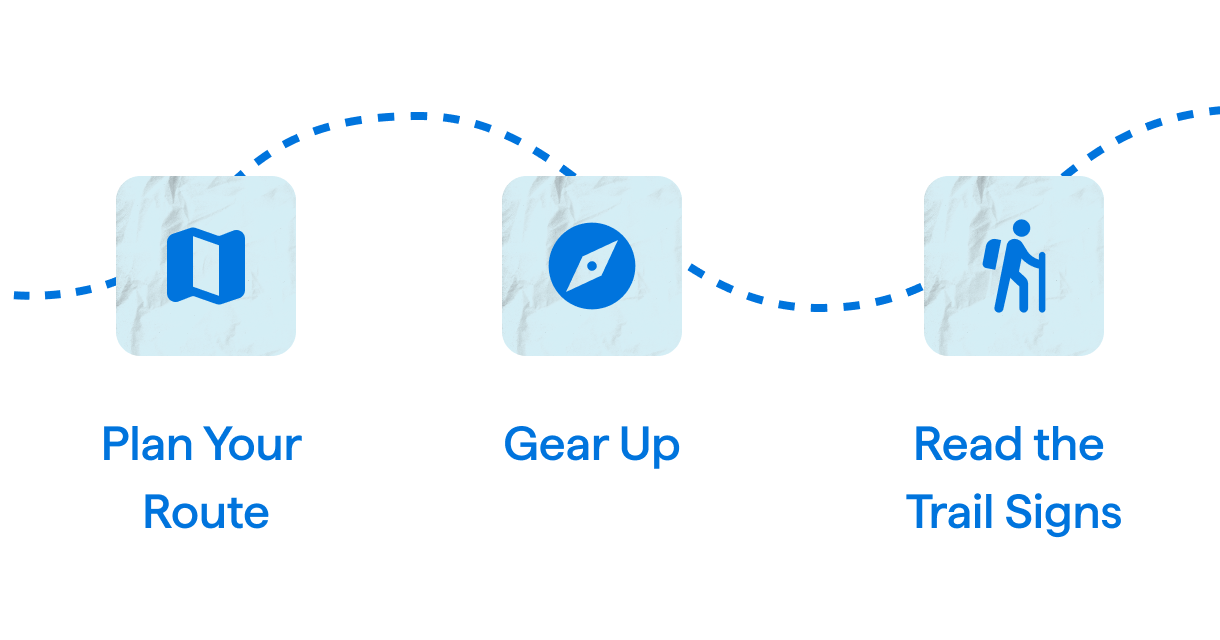
At times, it can feel like you’re guiding candidates through the wilderness down an unknown trail. Together, you might face some challenges along the way: from competing offers, to changing leadership requirements, to unmet expectations, you never know what might lie beyond the next bend in the trail. Whatever obstacles you may face on your journey, this book is here to help you chart a path to success and improve the candidate experience.
In the next five chapters, we’ve compiled expertise from seasoned talent acquisition professionals to help you lead your candidates through the recruiting process. We’ll teach you how to navigate five potentially rocky candidate conversations, including what hazards to expect and how to circumvent them successfully. Soon, you and your candidate will be gazing back from the summit after another successful hire!
The pre-closing technique – letting candidates know your interest in them early in the recruiting process to help ensure they’ll accept an offer
quickly – is a risky path. While recruiters go through the pre-closing process hoping for the assurance of a good hire, you can’t be certain how it will turn out.
If you choose to go this route, we’re here to help. Follow these steps to build your confidence that the result will be worth the risks you take while guiding your candidate.


You need to know what you’re getting into before exploring a new trail, especially when guiding candidates on it. Step one is about planning a route that takes into account the candidate’s priorities and avoids obstacles that might dissuade them from accepting your offer.
It’s never too early to start planning
The primary purpose of pre-closing is to increase the chances of landing your first-choice candidate. You want to keep them from veering off course or turning to another recruiter. Research your candidate and learn their preferences and motivations early on. The more you know about them, the better you can map the course to keep them excited about the journey.
“The more a candidate is brought in, earlier, the more context you have and the easier your success will be. If you wait to close until the end of the process, you’re more likely to be thrown off because the candidate’s terms, conditions, or expectations have changed while you waited.”
– Efrat Dagan, Founder & CEO at Workaround
Some alternate routes are worth taking
According to research by Robert Half Talent Solutions, over two-thirds of candidates have turned down their dream job because their first-choice employer’s hiring process took too long. Invest in the candidate experience and work with the candidate’s timeline. When you move the candidate quickly while keeping them informed and involved, you decrease the chances of losing their interest.
For example, many recruiters don’t communicate with candidates until there’s new information to share. Take a different approach. Check in weekly with your candidate, even if you’re still awaiting the next steps, to build trust and keep them involved throughout the process. Use each interview as an opportunity to get in touch with the candidate afterward to hear how they’re feeling and check if any other job opportunities have come up since you last spoke. By staying in close contact, you can strengthen your relationship with your candidate and avoid any surprises when it’s time to make the offer.
Good communication means better navigation
Being honest with a candidate saves time and builds trust, even if you can’t find the most direct route toward employment. Communicate the information you do have and restate your intentions to guide them to success, no matter how winding the path may be.
As a recruiter, it’s your job to own the communication and equip your candidate with the information they need to navigate additional interviews, skills tests, or other requirements they might face. Find the right balance between helping your candidate prepare for what’s ahead, while avoiding giving away too many specifics, like the lineup of questions that will be asked during the next interview.

Next, gather what you need to navigate the pre-closing conversation successfully. Just like every adventure requires the proper gear, recruiters should rely on tools like an interview intelligence platform. With the help of interview intelligence, you can rewatch key interview moments to refresh yourself on the candidate’s needs, motivators, and expectations. When you’re ready to pre-close, you can use this insight to refine your pitch and keep your candidate excited about the role.
Just as a hiker might pack essentials, like a first aid kit or wildlife reference guide, you should prepare responses to benchmark questions about the role you’re hiring for. Position, company, and salary details are likely to come into play during every pre-closing conversation.

Don’t miss those important warning signs at the start of the path.
Trail warning 1: Level set on compensation
Compensation is an important part of every pre-closing conversation, but it shouldn’t be the only thing they care about. If every conversation about company culture and work/life balance seems to somehow circle back to compensation, this candidate’s tunnel vision might limit them from success.
If you’re concerned, ask deeper questions to see if the candidate can move beyond that singular focus. Asking things like “what motivates you to be successful?” and “what job aspects are most important to you as you search?” is a subtle way to understand their intentions and priorities. Even if you’re comfortable with their answers, proceed with caution and look for similar warning signs in the future.
Trail warning 2: Make sure expectations are aligned with the role
During your conversations, your candidate may reveal potential roadblocks to a pre-closing acceptance – perhaps they are too optimistic about vacation and personal time, or have misaligned management expectations. Failing to address these concerns from the first contact to when you extend the offer could unintentionally lead you both to rough terrain.
Double-check your interactions. Make sure you’re focused on the candidate, tailoring every touchpoint to recognize, address, and navigate their concerns so they can move past any challenges. For example: imagine you’re interviewing a candidate who is concerned about a long commute to the office. This would be a great time to alleviate their concerns by highlighting flexible work options (if your company has them), such as remote or hybrid work policies.
Trail warning 3: Discuss a candidate’s preferences
It’s crucial to take your time and get to know the candidate so you’re not blindsided by something that could have been anticipated. You can’t fully understand how a candidate makes decisions based on a few limited interactions. For example: is the candidate passionate about workplace affinity groups or activities? Do they care about having a certain level of flexibility in work hours? The more you know about what makes your candidate tick, the more effectively you can pre-close and anticipate their reactions.
A simple way to do this is to have a thorough pre-screening process that focuses specifically on the candidate’s top priorities. By asking about their preferences surrounding things like salary, leadership/team style, and work environment off the bat, you’re less likely to be blindsided by unknowns later.
“I try to make the initial screening all about the candidate. I record the interview so I don’t need to be distracted by taking notes or reviewing their resume and can just focus on getting to know the person in front of me.”
– Amina Abdi-Nur, Recruiter at Animalz
After looking at photos, exploring blogs, checking weather forecasts – and then evaluating their own experience as hikers – people show up at the head of the trail with certain expectations.
Job candidates are no different. And today, they’re in a much better position to demand what they’re worth, thanks to the abundance of resources and public data available. From speaking with industry peers to reading salary data online, many resources help candidates understand market trends and how they reflect the value they can bring to the table.
As a recruiter, it’s your job to learn what lies ahead and plan a journey that matches the experience of your candidates. Come prepared with a salary range for the role and gauge the candidates’ salary expectations early on in the process. The key is to strike a balance between meeting their compensation expectations and landing on an offer that matches their expertise.

A smart trail guide knows better than to become complacent in case of unforeseen events. In the same way, you have to prepare for the compensation conversation regardless of how much recruitment experience you have.
Study the landscape
Take some time to study the current compensation landscape and analyze salary data for the position you’re recruiting.
In addition to searching online for competitive salary estimates, you want to understand the internal salary structure of the company you’re hiring for. It’s also good practice to understand how things like sign-on bonuses, promotions, and raises work, as candidates are likely to ask about these.
Compare their (potential) offer with the average salary currently offered in the market. If the hiring manager’s offer is well below the market average, suggest that the team make some adjustments before moving ahead with recruitment. Set clear expectations about the talent you’ll find if the hiring manager resists matching the standard.
Before taking a turn down the compensation path, make sure you have the information you need to navigate the conversation with your candidate successfully:
Things to know before you have this conversation:
Check in with your candidates
Recruiters need to ask candidates about their salary expectations as early in the process as possible. Ideally, the candidate’s expectation falls within both the market average and the hiring manager’s range.
This information will help you prepare in case candidates expect more than what’s promised. You will have time to consult with the hiring manager to see if they might match or counter a candidate’s requested salary, or supplement the offer with non-salary perks, such as remote work, flexible hours, and wellness stipends, to name a few.
You also get an opportunity to identify any outliers, specifically those with expectations that exceed the employer’s budget by an unreasonable amount. Ask these candidates additional probing questions about their qualifications and experiences in the initial interview. Rachel Clark, Revenue Recruiter at Salesloft, says, “Candidate expectations are changing rapidly. To help us stay on top of the evolving market, our recruiting and compensation teams work together to track market salary averages and re-run compensation numbers regularly to ensure alignment.”
Today’s market is evolving so quickly that salary data can grow stale in a matter of weeks. Lean on tools like Pave to scan the market landscape and benchmark your compensation data in real-time.

Keep an eye out for these compensation-related warning signs you might encounter.
Trail warning 1: Always consider cost of living
Many jobs get candidates from different regions, especially if companies are geographically dispersed and hiring remotely. This makes the journey ahead trickier, as compensation usually depends on the cost of living, which varies significantly from region to region.
Take that variation into account when looking at the expected compensation. Is the employer open to adjusting the pay according to the region? Or are they offering a uniform package everywhere? Answers to such questions will tell you if you have the leeway (and the authority) to offer more or less based on the candidate’s location.
Trail warning 2: Don’t leave out important benefits
There’s more to compensation than just base salary. Candidates evaluate the package as a whole when negotiating or considering a new offer. Look beyond base pay and find out if there are additional benefits that candidates might expect, such as bonuses, vacation days, stock options, or 401(k) matching.
A quick look at websites like Indeed and Payscale will help you uncover the benefits and perks of different roles. You’ll be in a much better position to negotiate if the company offers competitive benefits. If not, negotiate by leaning on region-specific pay and the employer brand, if possible. Or consider asking what perks the candidate might find attractive and see if the hiring company can offer them.
“Compensation is, of course, important to candidates. But they often have other motivators too. I always try to understand the bigger picture by asking on the first call what a candidate is looking for in their next role. That way, once we get to the end of the process, I can reiterate the things beyond compensation that they expressed were important.”
– Rachel Clark, Revenue Recruiter at Salesloft
At this point in the conversation, you’ve already gotten to know your candidate and triple-checked their salary expectations to make sure they’re in alignment. It’s understandable that you would keep trekking confidently toward your goal. You might think your candidate has a good understanding of the compensation a position entails – until an unexpected roadblock pops up.
Sometimes it’s difficult to see what might prompt a candidate to request changes to compensation they previously agreed to.
“Most sophisticated [candidates] and negotiators understand that everything is negotiable, but salary negotiations are a different stage in the process. Once you tell a candidate you’re wanting to move forward, the power equation changes. They have more [power] than they had in the hiring process.”
– Efrat Dagan, Founder & CEO at WorkaroundKeep the candidate moving toward employment by anticipating potential compensation challenges. Use your recruiting tools and research to provide answers and get back on course, and watch out for other compensation-related red flags you might encounter.

You can’t keep compensation discussions in check without understanding why your candidate requests a change. Maybe they have concerns they were afraid to voice before, or their personal circumstances have changed and affected their needs. Whatever the case, you have to find a way to get back on course.
Asking deeper questions allows you to better understand your candidate’s motivations and gain insight into their thought process so you can stay on the right track. Here are two situational questions to ask to help navigate unexpected compensation requests:
When we spoke earlier, I didn’t sense you had concerns about this position’s compensation package. Has something changed?Gently remind the candidate of their previous agreement while opening the door for them to share new information. For example, maybe they recently received another offer that they’re considering. This is important to find out, so you can address the situation head-on.
Once you identify their roadblock, follow up with this question:
What specific part of the compensation package isn’t working for you?You can better navigate a roadblock when you understand specifically what the candidate wants changed. Going back to the example of the candidate who’s considering another offer, maybe they’re looking for a role that allows them to work from home full-time, but the other offer on the table doesn’t provide that flexibility. Look for opportunities to incorporate remote work into your offer, so you can better meet your candidate’s needs.

You’ve researched the market and salary data to make sure the salary package offered to your candidate is fair, but they’ve changed the game. Referencing the original job description can provide you with additional support.
If the candidate is suddenly unhappy with the compensation package and you determine their hesitation is unmerited, direct them back to previous salary-related conversations. At times, simply reminding them why and how the compensation package is structured the way it is and providing more industry research to back up these reasons can be enough to mitigate concerns.
When in doubt, ask a colleague: don’t be afraid to consult more senior recruiters if you aren’t sure how to push back on a candidate’s request. They may have other tactics learned from years of guiding candidates.
“I just simply say, ‘Well gosh, help me understand where you came up with that number? I’d love to understand what research you did that gave you that number.’ Then, just wait. Silence is your friend in a scenario like that. A lot of times they’re either going to come back to you and have some wackadoodle answer. Or they’re going to say, ‘Well, what does it pay?’ Then you can redirect [the conversation] back to the Land of the Real.”
– Amy Miller, Senior Recruiter at Microsoft

Don’t let your familiarity with the journey desensitize you to warning signs.
Trail Warning 1: Prepare for potential requestsWhile it’s impossible to know what unusual compensation requests a candidate might have, you can familiarize yourself with common requests and have answers ready.
Three potential questions a candidate might ask are:
Knowing how the hiring company answers these common questions (and if there’s any room for negotiating them) in advance gives you even more authority to handle them confidently.
Trail Warning 2: Don’t catch candidates off-guardNon-disclosure agreements, as well as non-compete and non-solicit clauses, protect a company’s confidential information. However, these can scare some candidates along the way. To avoid this unexpected issue:
Trail Warning 3: Be transparent with candidatesThere may be things you’re aware of, but that are beyond your control, that you’ll need to navigate to keep your candidate moving forward. Maybe you know you can’t bring a competitive offer to the table. Or perhaps you can’t meet a compensation change the candidate requests even after negotiating on their behalf.
The earlier you address these unavoidable hazards, the better – and a straightforward conversation will likely be appreciated. It’s your job as a recruiter to be honest and realistic with your candidate and maintain their trust.
Imagine this scenario: A candidate shows great promise from the beginning. They do everything right – play by the rules, tick all the boxes, and put their best foot forward. But to your surprise, the hiring team isn’t convinced they’re the right fit. What now?
All is not lost. There are often chances to turn things around. While you can’t make the final decision, you can influence it if you feel the candidate deserves it.
“If you’re not on the same page as your hiring team, jump on a call together to understand their hesitations and what they’re looking for that the candidate doesn’t have. Having an open discussion may also give you an opportunity to sell them on the candidate or overcome their objections.”
– Rachel Clark, Revenue Recruiter at SalesloftBut how do you know when it’s appropriate to advocate for a candidate and push back on the hiring team’s assessment? The key is to reexamine the hiring team’s process and use the recruitment tools at your disposal.

Experienced trail guides know when to push ahead and when to call off the hike. The same applies to recruiters when a candidate is rejected by the hiring team. Know the difference between instances when you should advocate for a candidate versus when you should stand back and respect the hiring team’s decision.
Don’t turn around at the first sign of rain. Instead, evaluate all of the variables before making the decision to let a candidate go.
Justify reasons for rejectionFirst, look for clear indications like comments explaining the rejection left by the people on the hiring committee. Compare them with the job description and the candidate’s experience and background. Then ask yourself: do those reasons justify turning down the candidate? If not, raise this issue with the hiring committee to see what might be misaligned.
“Be attentive to your hiring team’s feedback throughout the process. If you pick up on signs that there is any misalignment, proactively dig into it to address concerns right away. That way, everyone is on the same page once it’s time to make the final decision.”
– Hayli Thornhill, Head of Recruiting at BrightHire
Look for potential biasOne way to detect potential bias in a hiring decision is to compare the profile of a shortlisted candidate with one who was rejected. If the rejected candidate has the same (or higher) level of qualifications and experience but differs in gender, race/ethnicity, age, or another aspect of their identity or life circumstance, that may be something to flag to a hiring team.
If an issue of potential bias is raised, ask the hiring committee to elaborate on their reasons for rejecting the candidate. Did they say something in the interview that the committee didn’t clearly highlight in their notes? From there, if you’re recording interviews, you can review clips from the conversation to dig deeper into the reasons the candidate was rejected. If you still aren’t aligned with the hiring team after your review, regroup with the team to rewatch the same clips, so everyone can have a clear, direct conversation about concerns.
Hiring bias persists in many workplaces, even when hiring teams do not realize it. For more information about what potential bias can look like and helpful strategies to combat it in your hiring process, check out our Interview Bias Tool Kit. Taking additional steps to address bias will help you hire more equitably and add to the breadth of talents and experiences in your organization.

When in doubt, leverage your recruitment tools like an interview intelligence platform to dig into the exact reason why a hiring committee may have rejected a candidate. By capturing data from the interview process, you can review specific answers and understand what a candidate may have said that led your team to decline them. With these tools, you can get a more holistic view of the situation that helps you address bias and overcome obstacles. You can also understand more about what the team is looking for so you can further refine the requirements for the role and reduce unnecessary interviews.
If you’re not recording interviews, applicant tracking systems such as Lever, Workable, or Greenhouse can be helpful. These tools enable hiring managers to submit scores to quantify the skills and competencies of candidates in a centralized location. Hiring managers are required to provide detailed reasons for why they’re rejecting a candidate on these platforms. Their notes on the candidate may strengthen your case for an appeal.
You can also leverage candidate surveys to gain better visibility into the interview process. Candidate feedback can help you determine if there were problems during the interview(s) that affected their performance.

Pay close attention to warning signs should you decide to push back on a hiring team that has rejected your candidate.
Trail warning 1: Address difficult interviewers
If a hiring team member is especially difficult or harsh with candidates, it’s your job to offer this person constructive feedback. As a recruiter, you have greater visibility into the entire hiring process. The people on the hiring committee may not be aware of issues and shortcomings that make their trail inhospitable.
“Most people are open to feedback and will change their ways if they know how. Getting the right person to provide the feedback and helping them see what other strategies would be useful usually helps.”
– Efrat Dagan, Founder & CEO at Workaround
Trail warning 2: Don’t delay communication
A candidate may drop out of the process and pursue another trail that looks more promising if you take too long to give them an answer. It’s always safe to assume a candidate is looking at other companies for similar positions. If you feel the candidate has significant potential and can bring value to the table, warn the hiring managers that you have a limited window of time.
Unfortunately, as a recruiter, you cannot promise every candidate you guide through the interview process will be rewarded with a job. In some cases, even candidates who receive offers aren’t guaranteed a spot on the team. Offers can be revoked for various reasons, from budget changes and internal reorganizations to failed background checks or licensure issues.
As a recruiter, pulling a job offer you’ve already given to a candidate is one of the toughest conversations you can have. However, it is important to remember that this outcome doesn’t make you or your candidate a failure. These circumstances are beyond your control, and neither of you needs to suffer permanent damage as a result. When you communicate the situation early, use clear documentation to support the decision and prepare for potential candidate responses to minimize negative outcomes.

Rejection is no fun for you or your candidate, especially when you both assumed good things were around the corner. However, maintaining professionalism, positivity, and clear communication help to soften the blow and keep the candidate’s experience as positive as possible. Part of that experience hinges on when and how you communicate the news.
“People feel significantly more connected through voice-based media than through text-based options, like email.”
– Amit Kumar, Assistant Professor of Marketing at McCombs School of Business (via Science Daily)
Whatever reason the hiring team has for revoking the job offer, this will be a reroute in the candidate’s adventure, not a dead-end. Stay positive and maintain transparent communication with the candidate throughout the process.
Even in these situations, there are alternatives. Another internal position might also be a fit for your candidate. You can also offer to keep their resume for future roles. If these aren’t good options, consider offering a positive recommendation or referring them to other recruiters with open jobs. Finish the interview journey strong, no matter your approach.

Support from your legal team and written documentation are the most helpful resources in this challenging position. These tools can give you more confidence to discuss a revoked offer.
Start by referencing the hiring team’s documentation of why a candidate was rejected. An applicant tracking system is one way companies document and organize these notes.
After confirming the reason for revoking the offer and calling the candidate to explain the situation, inform them that a more formal revocation notice will follow via mail. This is where your human resources and legal team come into play.
The legal and HR teams should review the revocation notice and confirm the legalities of your proposed written communication. Covering your bases with this extra step offers clear support for your and the hiring team’s position, so there are no gray areas or room for miscommunication moving forward. Make your role and how you can further support your candidate, clear. This makes them less likely to push back on the revocation.

Be prepared to respond to a candidate’s reaction to a revoked offer, so you can maintain your composure and professionalism even in a highly emotional situation.
Trail Warning 1: Balance professionalism with empathy
Even when following the steps above, candidates will likely be shocked, upset, and disappointed when you share the news. Put yourself in their shoes and maintain the professionalism you’ve exhibited along the trail.
It is possible to reassure the candidate of their worth and skills without getting too personally involved. This reassurance will help to maintain your good relationship with the candidate beyond this specific role. Find this balance by following some of the examples below:
DO: Express your sympathy to the candidate (“I’m very sorry that this outcome is not what either of us was hoping for”).
DO NOT: Personally apologize for the situation – after all, it is not your fault, and for the sake of your own reputation you should not imply that the outcome is due to any error on your part.
DO: Encourage the candidate (“You have great experience and skills that would be valuable to a company…”).
DO NOT: Tear down the employer that rescinded the offer; assume and express best intent, even if you are frustrated with the employer yourself (“… but unfortunately, sometimes even the best companies aren’t able to perfectly anticipate their needs”).
Trail Warning 2: Expect the unexpected
Just like an unexpected storm, candidates might suddenly get angry and lash out in response to a revoked offer. Their emotion is understandable after the expectations were set for them, so try to respect the storm, rather than fight against it. Treating the candidate with dignity – no matter their response – is the best way to maintain the hiring company’s reputation and your relationship with the candidate.
“Rescinded contracts can lead to bruised human egos and broken dreams. While having legal immunity helps, treating them with dignity while communicating the job rescinding, and going out of your way to help them find a suitable placement can help repair their goodwill.”
- AttendanceBot
Perhaps the most nerve-wracking (or thrilling!) part of any adventure is reaching the point in your trail that’s beyond the edge of your map.
Maybe it ended just as you expected, and you and your candidate are looking back on your journey with satisfaction as you celebrate their employment. Or, perhaps you’re re-stocking your pack to explore a new trail in search of a better candidate for the job. Whatever the case, we hope these chapters have made you more confident in your recruiting skills and given you signposts and tools to reassure you as you guide others.
Now, it’s your time to shine! Share your own “Expert Trail Guide Tips” with other recruiters, or email them a copy of this trail guide so they can enjoy the adventure for themselves.
Of course, these five difficult conversations don’t cover the full spectrum of challenges you might encounter during your time as a recruiter. Thankfully, you can rely on other tools, like new technology, video capabilities, and interview resources to better equip you for unknown challenges. BrightHire’s interview intelligence platform offers the best of all three to help companies build exceptional teams faster and with less bias. Book a demo today, or check out our blog for more resources on recruiting best practices and how to hone your craft.